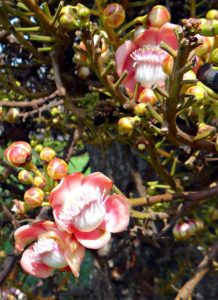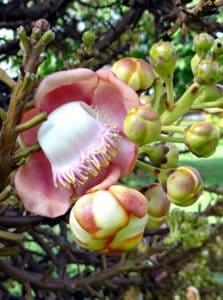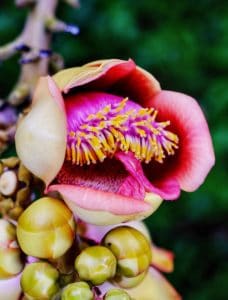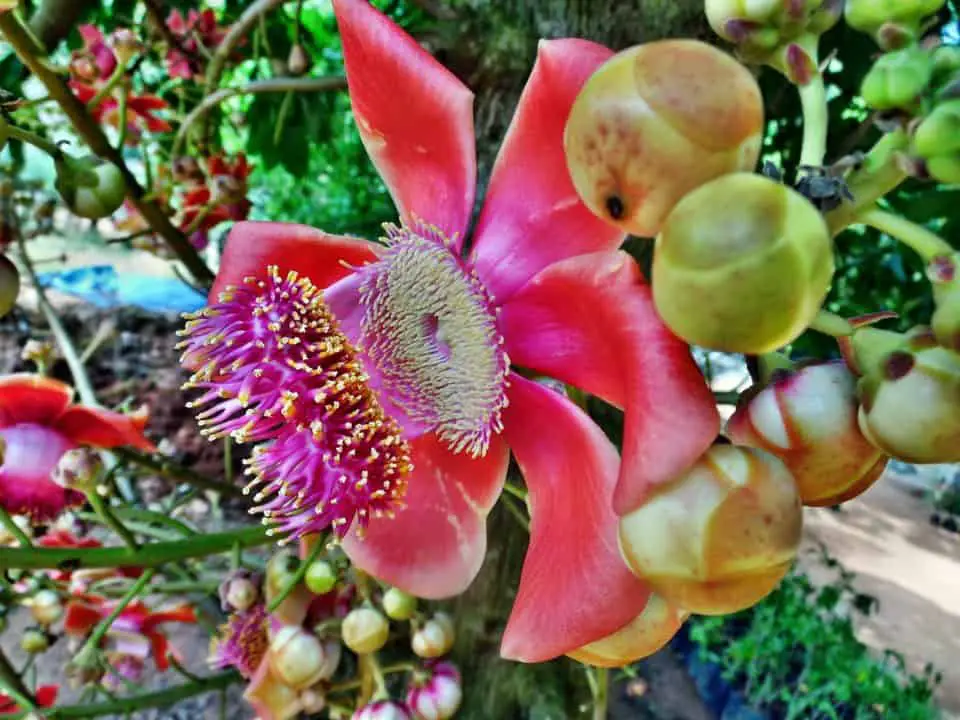Some links in the post are affiliate links and I get a commission from purchases made through some links found in the post.
The Naga Linga tree goes by a myriad of names, among them Kailaspati, Mallikarjun, Nagamalli, Cannon Ball, Couroupita guianensis, and Shiva Linga.
The name depends on where you come across the plant, but all these point to the same plant- a sacred tree in Hindu traditions.
In Sanskrit, Naga means snake, and Linga points to Lord Shiva, a Hindu god’s idol.
The naming points to the appearance of the plant, which has flower petals covered by a hood.
The petals look like Naga, a sacred snake, and it looks like the petals have the coverage of Linga. You can see where the name comes from.
It’s even more interesting that the trees are common in Lord Shiva temples in India, with many people believing that praying to Lord Shiva with the Cannon Ball flowers washes away their sins.
Besides religious beliefs, this tree also receives praise for its cosmetic benefits with its beautiful rosy-purple flowers coupled with its large fruits.
It has also been used for medicinal purposes, with people relying on its fruit pulp to ease headaches. Its leaf juice is also used to promote hair growth.
Please note that other than ornamental purposes, this blog does not encourage the use of any natural products for health purposes without similar direction from your doctor.
How to Care for a Naga Linga Tree (Cannonball Tree) in Your House
 With its round-shaped beautiful flowers exuding a powerful scent, it makes sense that you would want this plant in your home.
With its round-shaped beautiful flowers exuding a powerful scent, it makes sense that you would want this plant in your home.
The smell is so strong that it has been used in perfumes, fragrances, and a range of cosmetic products.
The flowers are also used to make medicines used in alleviating conditions such as inflammation and hypertension. How great would it be to wake up to this beauty every day?
The tree is well-adapted to indoor conditions, making it easy to grow in any of the fifty states.
If the plant has been outdoors, you need to gauge the temperature drops, and before they hit forty degrees, you need to move it inside.
Container Selection
Cannonball trees do well in containers as long as you choose the right size that accounts for root development.
Keep in mind that these trees are fast growers and often require spacing out when growing outdoors.
Essentially, growing them in the ground requires that you space the rows by twelve feet each.
And when growing them as individual trees, you need to keep them at least five feet away from other trees.
You can thus imagine how much space they need. That said, keeping them indoors is doable as long as you choose a deep and wide container.
The pot should have at least eighteen inches in diameter and at least twenty inches to account for height.
Drainage is a big issue as the plant will not do well in poorly draining soil.
Also, make sure that you drill enough drainage holes to prevent waterlogging, paving the way for one of the biggest plant enemies- root rot!
If you want to reduce your watering frequency, opt for glazed pots.
Please note that you should have one tree per pot to ensure the plant gets enough nutrients without suffering competition for its basic needs.
Soil
As earlier stated, the cannonball tree does well in well-draining soil and will not thrive in waterlogged soil.
Ensure that the soil does not retain water for long to prevent the plant’s roots from sitting in water for prolonged periods.
You can do this by mixing soil, perlite, and sand to create a well-draining yet nutrient-rich mix.
If you notice water sitting at the top of the surface for long, you may need to change the potting mix.
Lighting
When growing in the outdoors, this plant prefers to be in bright and direct sun.
Gardeners see great results when they expose these plants to 12 hours of bright sun each day.
However, even with 30% shade, the trees do well. How can you do this indoors? Start by finding a window location with a lot of southern exposure.
The window should have a bright and sunny environment, enabling the plant to be in sunlight most of the time.
Artificial lighting is hardly necessary, but you may need to provide this if you live in a dark area.
Watering
Watering can kill your tree in two ways- overwatering and underwatering.
Striking a balance between these two extremes is often a challenging task, but you can do it.
Each time you want to water the plant, dig a finger into the top three inches of the soil.
If they are dry, you can lightly soak the soil. Please note that the soil should remain damp and not wet to ensure that the roots do not have more moisture exposure than is necessary.
Doing so would create a mucky environment that would cause root rot.
If you are not sure of how to check the moisture levels, you can always buy a moisture gauge to take the guessing aspect out of the equation.
It is especially important when the light conditions cause the soil to dry fast, and you find yourself watering the soil daily.
You would want to make sure that the soil needs the moisture before adding more and probably killing the plant.
Fertilization
 Does your cannonball tree require fertilizer? Yes and no. These trees are moderate feeders, and during the growing season, you will need to fertilize them as you water the soil.
Does your cannonball tree require fertilizer? Yes and no. These trees are moderate feeders, and during the growing season, you will need to fertilize them as you water the soil.
It helps the plant to grow strong and give good produce come harvest season.
During the dormant stages, you can take a step back and allow the plant to make do with what it already has.
Work with time-released inputs and ensure that they cannot kill or burn the tree.
Also, there is such a thing as over-fertilization, and you will want to make sure that you have followed the manufacturer’s instructions to the letter.
If you are not interested in fast growth, you can do away with using inputs, and the tree will grow at a stunted rate.
On the plus side, you will not run the risk of heavy salt accumulation in the soil that can damage the root system.
If you’re enjoying this article, check out our article on what are the fastest growing evergreen trees for small gardens.
How to Grow a Naga Linga Tree (cannonball tree) From Seed in Your House
Given the expansiveness of the roots, you need to get a large pot for each tree. The pot should be at least 24 inches wide with a height allowance of 20 inches.
Also, make enough drainage holes to prevent the soil from getting waterlogged and causing root rot.
The best potting mix will incorporate soil, sand, and perlite. Put enough potting mix in the pot and leave an allowance of one or two inches at the top to allow for watering.
Sow the seed directly under the layer of the soil. You can do this even without using fertilizer or treating the seed and the soil, and it will still do well.
Place the pot in an area that can get at least six hours of sunlight, which would be towards a southern window.
If the area can get up to twelve hours of direct sunlight, the better the plant will do.
Water the soil to the point of being damp and allow it to drain the excess water before moving the pot to its original position.
You can now keep up with watering needs and other care practices based on the requirements we earlier covered.
Keeping up with these will see the seeds germinating within 8-15 days.
If you want to move the seedlings, wait until they are at least 6 centimeters tall. The seedlings will take at least one year to bear fruit.
Naga Linga Tree (Cannonball Tree) Growth Rates
These trees are fast growers, and in their native region, they have been known to grow to heights of 50-75 feet.
Sometimes, they can hit 100 feet. It is unlikely that the tree will reach such heights in a non-indigenous region.
It is likely to cap its rate at 50 feet in your outdoors. You may want to consider this when planting the tree indoors.
Is the Naga Linga Tree’s (Cannonball Tree’s) Fruit Edible?
Wondering where the cannonball name comes from? Well, this tree produces a ton of fruits that resemble the cannonballs used in war.
They are large, round, and fall with a thud on the ground before bursting open. More often than not, they lie there for animals to feed on.
The fruits are edible, but you will rarely find people eating them because of their unpleasant smell.
You may want to check with your doctor before consuming the fruits or any parts of this plant.
Where Does the Naga Linga Tree (Cannonball Tree) Grow?
 This species is native to the Amazon. However, it can grow in any region provided the soil is rich and moist, and the location has 80-100% access to bright sunlight.
This species is native to the Amazon. However, it can grow in any region provided the soil is rich and moist, and the location has 80-100% access to bright sunlight.
In the outdoors, it does best in zones 10a to 11, and indoors, it can work with zones 4a to 11.
Amending indoor conditions can also enable the plant to do well even outside its zone, thanks to the tree’s minimal growing requirements.
Final Thoughts: How to Care for a Naga Linga Tree in Your House
Caring for a Naga Linga tree, whether in your house or outdoors, should be a pretty easy task given its minimal growing requirements.
As long as you are moderate with your approaches, the tree should do just fine. Happy Gardening!
Before you go, here are some more related articles I encourage you to read below to help solve more of your gardening issues:

